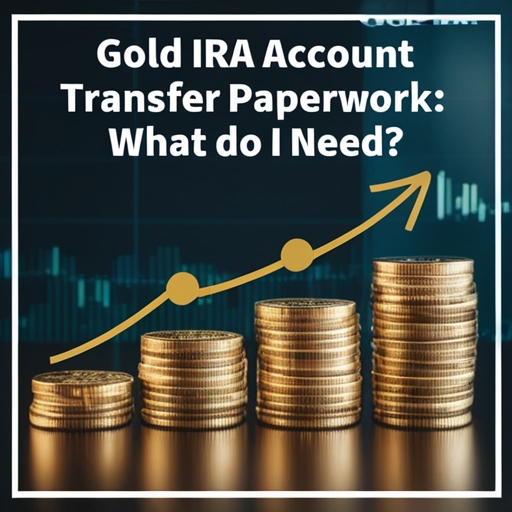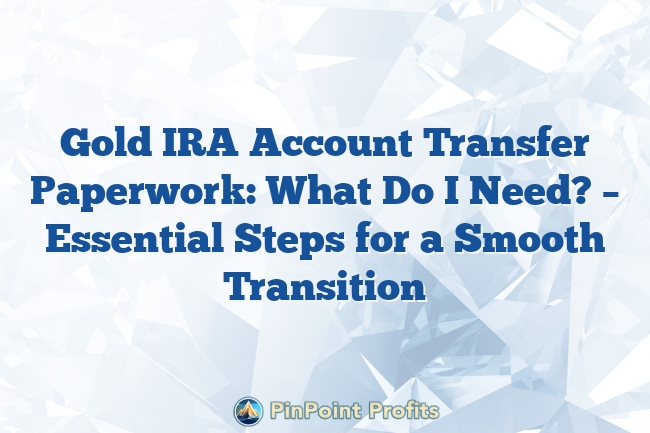Transferring a Gold IRA account can be a strategic move to diversify your retirement portfolio and protect your wealth against economic uncertainties. This comprehensive guide will walk you through the entire process, ensuring a smooth transition for your precious metals investment.
| Key Points | Description |
|---|---|
| Required Documents | Current IRA statement, ID, transfer request form, new account application, beneficiary form |
| Steps for Smooth Transition | Choose reputable custodian, complete paperwork accurately, communicate with custodians, consider timing |
| Common Mistakes | Not verifying IRS-approved gold, exceeding contribution limits, poor communication, overlooking fees |
| Benefits | Portfolio diversification, inflation hedge, potential growth, tax-deferred growth, asset preservation |
| Drawbacks | Storage costs, market volatility, limited liquidity, IRS regulations, may not suit all investors |
What Documents Are Required for a Gold IRA Account Transfer?
Initiating a Gold IRA account transfer requires specific documentation to ensure a smooth and compliant process. Your current IRA account statement is essential, providing details of your existing investment. Identification documents are necessary for your new IRA custodian to verify your identity and comply with regulations.
A transfer request form is crucial, authorizing the movement of funds from your existing IRA to the new Gold IRA. Accuracy in filling out this form is paramount to avoid delays. The account application for your new Gold IRA sets up your account with the chosen custodian, so ensure it's completed thoroughly.
Don't forget the beneficiary designation form, which specifies who will inherit your Gold IRA. This document is vital for estate planning purposes. Lastly, having a copy of the IRS-approved gold list is beneficial. It outlines eligible gold bullion and coins for your IRA, guiding your investment choices.

Steps to Ensure a Smooth Transition
A smooth transition begins with choosing a reputable IRA custodian experienced in managing precious metals IRAs. Research potential custodians thoroughly, considering their track record and customer reviews. Complete all necessary paperwork with utmost accuracy to prevent delays or complications.
Maintain open communication with both your current and new custodians. They will coordinate the transfer of funds and assets, so staying informed is crucial. Consider the timing of your transfer, as market conditions can affect the gold spot price, impacting your investment's value.
Finally, review your overall retirement portfolio. Ensure your Gold IRA aligns with your investment strategy, considering factors like portfolio diversification and inflation protection. This holistic approach will help maximize the benefits of your Gold IRA transfer.
Common Mistakes to Avoid During the Transfer Process
Avoiding common pitfalls can save time, money, and stress during your Gold IRA transfer. One critical mistake is not verifying the IRS-approved gold list. Investing in non-approved gold can lead to penalties and complications with your IRA.
Another error is overlooking IRA contribution limits. Exceeding these limits can result in tax penalties, so ensure your transfer complies with IRS regulations. Poor communication with your custodians can lead to misunderstandings and delays, so stay proactive in your correspondence.
Neglecting to review fees is a costly oversight. Different custodians have varying fee structures, so compare options to find the best fit for your Gold IRA. Lastly, don't underestimate the importance of physical gold storage. Ensure your precious metals are stored in a secure, IRS-approved depository to protect your investment and comply with regulations.
Selecting the Ideal Custodian for Your Precious Metals IRA
Choosing the right custodian is crucial for the success of your Gold IRA. Start by researching potential custodians, focusing on their experience in managing precious metals IRAs. Look for a track record of reliable service and positive customer feedback.
Evaluate their fee structure and additional services. Some custodians offer extras like custodial services and metals exchange, which might benefit your investment strategy. Ensure they provide secure physical gold storage in an IRS-approved precious metals depository.
Customer service is paramount. A responsive custodian can address concerns promptly and provide guidance throughout the transfer process. Consider their communication channels and response times when making your decision.
Tax Implications of a Gold-Backed IRA
Understanding the tax implications of a Gold IRA is essential for maximizing its benefits. A Gold IRA is a tax-deferred investment, meaning you won't pay taxes on gains until you withdraw funds. However, incorrect transfers can trigger taxes, so ensure yours is a direct rollover to avoid penalties.
Be aware of the tax advantages of IRAs. Contributions to a traditional Gold IRA may be tax-deductible, potentially reducing your taxable income. Consider how a Gold IRA impacts your overall retirement portfolio, offering inflation protection and diversification benefits.
Consult a tax professional for personalized advice on IRS regulations and tax implications. Their expertise can ensure compliance and help you maximize the tax benefits of your Gold IRA.
Advantages of Transferring to a Precious Metals IRA
Transferring to a Gold IRA offers several compelling benefits:
- Portfolio diversification: Gold acts as a safe-haven asset, balancing your investments.
- Inflation hedge: Gold's value often rises with inflation, protecting your purchasing power.
- Growth potential: Gold prices can increase over time, offering capital appreciation.
- Tax-deferred growth: You won't pay taxes on gains until withdrawal, allowing efficient growth.
- Asset preservation: Physical gold storage ensures your investment's security.
These advantages can enhance your retirement portfolio's stability and potential for long-term growth.
Potential Drawbacks of a Self-Directed IRA Transfer
While Gold IRAs offer numerous benefits, it's important to consider potential drawbacks. Physical gold storage incurs costs, which can impact your investment's overall return. Market volatility is another consideration, as gold prices can fluctuate, affecting your investment's value.
Limited liquidity is a factor to consider. Selling gold can take time, potentially impacting your ability to access funds quickly. IRS regulations governing Gold IRAs are strict, and non-compliance can result in penalties.
Lastly, a Gold IRA may not suit all investors. Evaluate your investment goals and risk tolerance carefully. Consider alternative investments if a Gold IRA doesn't align with your overall financial strategy.
Timeline for the IRA Rollover Process
The duration of a Gold IRA transfer can vary, but typically takes a few weeks to complete. The efficiency of your custodians and the accuracy of your paperwork play significant roles in the timeline. Here's a general breakdown:
1. Account setup: 3-7 days
2. Fund transfer: 7-14 days
3. Gold purchase: 2-5 days
The initial account setup involves completing applications and forms. The fund transfer step moves assets from your current IRA to the new Gold IRA. Finally, you'll select and purchase gold bullion or coins once funds are transferred.
Patience and attention to detail are crucial throughout the process. Maintain regular communication with your custodians to ensure a smooth and timely transfer.
Understanding Fees Associated with Gold IRAs
Comprehending the fee structure is crucial when transferring to a Gold IRA. Fees can vary significantly between custodians, impacting your investment's cost-effectiveness. Common fees include:
– Setup Fee: One-time cost to establish your account
– Annual Maintenance Fee: Ongoing cost for account management and reporting
– Storage Fee: Cost for storing physical gold in a depository
– Transaction Fee: Charges for buying or selling gold within your IRA
Compare these fees across different custodians to find the most cost-effective option for your Gold IRA. Consider how these fees might impact your investment's long-term performance.
Monitoring Your Transfer Progress
Tracking your Gold IRA transfer is essential for a smooth process. Maintain regular communication with both your current and new custodians. They can provide updates on the transfer status and address any concerns.
Utilize online account access if available. Many custodians offer online portals where you can track your account and transfer progress in real-time. Set reminders for key milestones, including account setup, fund transfer, and gold purchase.
Request written confirmation for each completed step. This provides assurance and documentation for your records. Be proactive in addressing any issues that arise. Quick action can resolve problems and keep your transfer on track.

Post-Transfer Management of Your Gold Investment
Once your Gold IRA transfer is complete, your account becomes active. You'll receive confirmation from your custodian, including account details and investment information. Review your account statement carefully to ensure all information is accurate, including your gold holdings and account balance.
Monitor your investment regularly, as gold prices can fluctuate, affecting your portfolio's value. Stay informed about market trends to make strategic decisions. Consider rebalancing your retirement portfolio periodically to maintain diversification and align with your investment goals.
Plan for future contributions, keeping in mind IRA contribution limits and tax advantages. Regular contributions can enhance your retirement savings and take full advantage of your Gold IRA's benefits.
Securing Your Precious Metals Investment
Securing your Gold IRA investment involves ongoing management and vigilance. Ensure your physical gold is stored in an IRS-approved depository, providing security and regulatory compliance. Regularly review your custodian's services to ensure they continue meeting your needs.
Stay informed about market trends affecting gold prices. This knowledge can help you make informed decisions about your investment strategy. Consider diversifying within your Gold IRA by including different types of precious metals or related investments like gold mining stocks or a Gold ETF.
Consult with a financial advisor periodically to review your gold investment strategy. Their professional insight can help you optimize your retirement savings and ensure your Gold IRA aligns with your overall financial goals.
Conclusion
Transferring your Gold IRA account is a strategic move that can enhance your retirement portfolio's diversity and stability. By understanding the necessary documents, steps, and potential pitfalls, you can navigate the process smoothly. Choosing the right custodian, being aware of tax implications, and carefully managing your investment post-transfer are crucial for maximizing the benefits of a Gold IRA.
While there are fees and potential drawbacks to consider, the advantages of portfolio diversification, inflation protection, and tax-deferred growth make a Gold IRA a compelling option for many investors. With careful planning, ongoing management, and professional guidance when needed, a Gold IRA can be a valuable addition to your investment strategy, offering both security and growth potential for your retirement savings.
What's the minimum investment for a Gold IRA?
The minimum investment varies by custodian but typically ranges from $5,000 to $10,000. Some custodians may have lower minimums to attract new investors.
Can I hold other precious metals in my Gold IRA?
Yes, you can hold silver, platinum, and palladium in addition to gold in a precious metals IRA, as long as they meet IRS purity standards.
How often should I rebalance my Gold IRA?
It's generally recommended to review and potentially rebalance your Gold IRA annually or when there are significant market changes affecting your overall portfolio allocation.

